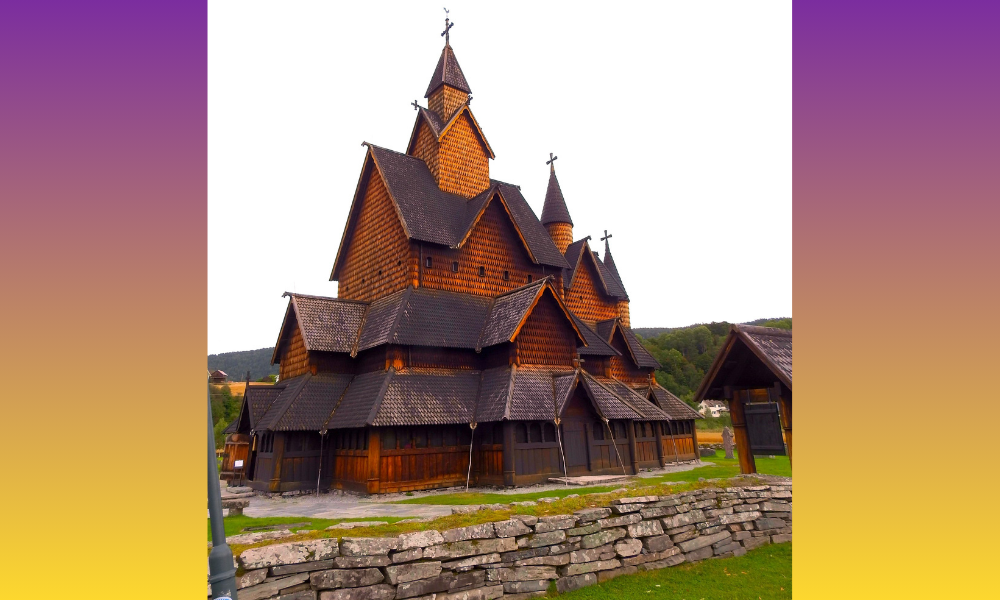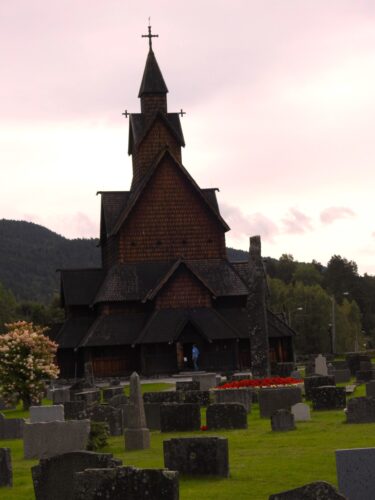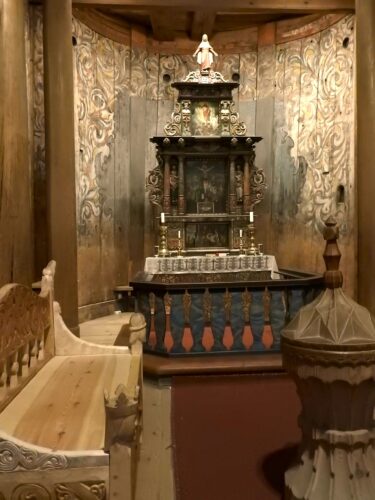Italiani nel Mondo
Tra Sacro e Profano – Viaggio dal Nord al Mediterraneo alla ricerca di risposte – Between the Sacred and the Profane – A journey from the North to the Mediterranean in Search of Answers

Tra Sacro e Profano – Viaggio dal Nord al Mediterraneo alla ricerca di risposte
di Carmelina Micallef
Immagina cosa potremmo diventare se ci ascoltassimo davvero. Se ci fermassimo un solo istante ad accogliere quei silenzi che parlano più delle parole, le tracce del passato che non smettono di continuare a vivere, le memorie che si nascondono nei luoghi sacri e profani. Forse scopriremmo che le risposte non sono lontane, ma già qui, intorno a noi, in ciò che resta e in ciò che continua.
Basta entrare in una chiesa, di quelle che non sembrano aspettare nessuno, ma che restano lì, per accorgersi che in quel silenzio qualcosa parla ancora.
In una valle norvegese, sorge Heddal, la più grande Stavkirche ancora in piedi. Una costruzione di legno che sembra uscita da una fiaba vichinga. Alta, scura, imponente. Qui il sacro è nato dal bosco. Ogni trave fu tagliata e incastrata da mani contadine con la loro pazienza, profonda conoscenza e fede. Nelle campagne, la gente si aiutava con le mani e con le preghiere, e il sacro nasceva così, non per dominare, ma per proteggere.
Dentro, il silenzio non è vuoto. Il pavimento in parte scricchiola e l’odore è particolare, misto di resina, legno antico e cera consumata. Appena si entra, si ha la sensazione di fare un salto indietro nel tempo. Tutto è legno. Alte colonne sostengono il soffitto e fanno sembrare la chiesa quasi una foresta al coperto. La luce crea un’atmosfera calma e raccolta. L’altare raffigura scene della vita di Gesù perché al tempo della sua costruzione, intorno al 1200, la Norvegia era già cristiana da un paio di secoli. Prima, i norvegesi seguivano il paganesimo norreno, venerando divinità come Odino e Thor, e anche dopo la conversione, alcune tradizioni sono sopravvissute.

Guardando meglio, i resti decorativi di origine vichinga e feste antiche furono trasformate in ricorrenze cristiane. I draghi, scolpiti sulle pareti riappaiono ancora oggi, anche nel mondo cristiano senza essere mai cancellati.
Fuori, un cimitero immenso abbraccia la chiesa con tombe umili, pochissimi ornamenti e solo qualche foto occasionale. Pulito, ordinato, con le iscrizioni di nomi, alcuni ormai consumati su qualche lastra inclinata.
Il turismo non è assente, ma ha un altro passo. Più lento, rispettoso, fatto di viaggiatori che osservano, cercano, ascoltano quello che hanno da sussurrargli gli altri venuti prima di loro. Non a caccia di souvenir, ma di un contatto difficile da definire e che, nonostante questo, li tiene inchiodati là, avvolti dallo stupore e da una strana serenità.
Alla chiesa di Heddal, le donne in una fase della loro vita non potevano varcare la soglia. Durante il ciclo mestruale o dopo un parto recente, dovevano aspettare di essere considerate “pure” prima di poter entrare. Non sempre era loro concesso passare dalla porta principale. A volte si servivano di ingressi laterali, altre volte potevano solo sbirciare i riti da piccole fessure all’esterno. Il sacro era lì, ma non sempre gli era permesso viverlo da vicino.
Sono cambiate le forme, ma gli ostacoli restano.
Oggi, guardando indietro è inevitabile pensare a quanto quelle regole assomiglino tanto alle barriere che ancora molte donne e uomini incontrano per avere piena dignità negli spazi sacri, sociali e culturali. Per fortuna, in alcuni paesi con vedute più ampie qualcosa ha iniziato a cambiare, segno che lentamente è ancora possibile l’apertura a nuovi spazi di partecipazione.

E certi segni, proprio come le rune graffiate nei pilastri di legno della chiesa, sembrano non svanire mai. Restano lì a ricordarci quanto la storia continui a parlarci al presente, e quanto spesso nessuno ascolta.
Scendendo più a Sud, nelle vallate italiane, i morti non si nascondono nel silenzio. I loro volti sulle foto ci sorridono ancora, rammentandoci che oltre quella soglia, nulla è interrotto.
Tra i vivi, le campane talvolta suonano a vuoto, eppure molte feste resistono. Processioni che uniscono ancora i borghi, anziani che accendono una candela, litanie che invocano alla salvezza.
Perfino chi non crede più, spesso si ferma a cercare qualcosa che non sa se esprimere con parole o con gesti.
Feste patronali, luminarie, bande musicali, mercati in piazza. Il sacro e il profano uniti nelle celebrazioni collettive. Non meno autentici, solo differenti.
Nel mondo vichingo e nordico antico, la morte non era considerata una paura assoluta. Per un nordico, l’incubo peggiore non era morire, ma vivere senza onore.
Con l’arrivo del Cristianesimo, la morte divenne un giudizio, la promessa del Paradiso o minaccia dell’Inferno. I defunti iniziarono a essere venerati, ricordati, spesso anche dimenticati.
Due modi diversi di dare un senso alla fine. Onore, memoria, salvezza, ogni civiltà ha cercato una strada per affrontare la fragilità della vita che accomuna tutti.
Oggi viviamo in una società che spesso rimuove la morte e nasconde il silenzio. Eppure, quella stessa domanda resta sospesa:
Come trovare un senso in ciò che un senso non ha?
È una domanda che non ha confini. Viaggia nei secoli, attraversa mari, lingue e culture, dal Nord al Mediterraneo, e oltre. In fondo, quello che ognuno di noi cerca è solo sentirsi parte di qualcosa più grande per il tempo che ci è concesso. Spesso la risposta l’abbiamo già ma non sappiamo interpretarla.
Smettere di camminare da soli e riconoscere che quella che chiamiamo la nostra storia, è in realtà inevitabilmente intrecciata a quella degli altri.
La mente si accende davvero, quando diventiamo parte di un unico racconto che continua a guidarci, e solo allora il senso appare, anche dove prima sembrava impossibile.
Between the Sacred and the Profane – A journey from the North to the Mediterranean in Search of Answers
by Carmelina Micallef
Imagine what we could become if we listened to ourselves. If we paused for just a moment to welcome those silences that speak louder than words. The traces of the past that refuse to disappear, the memories that hide within places both sacred and profane. Maybe we would discover that the answers are not distant at all, but already here, around us, in what remains and in what continues.
Enter a quiet church, and you’ll feel that its silence still speaks.
In a Norwegian valley stands Heddal, the largest Stavkirke still in existence. A wooden structure that seems to have emerged from a Viking legend. Tall, dark, and imposing. Here, the sacred was born from the forest. Every beam was cut and fitted by peasant hands, with patience, craftsmanship, and faith. In the countryside, people helped one another with their hands and with their prayers. That’s how it all started, not to dominate, but to protect.
Inside, the silence is not empty. The floor creaks in places, and the air carries a distinctive smell, a mixture of resin, ancient wood, and melted wax. The moment you step in, it feels as though you’ve leapt back in time. Everything is wood. Tall columns hold up the ceiling, making the church feel almost like a forest under cover. The light creates a calm, welcoming atmosphere.
The altar shows scenes from the life of Jesus, since by 1200 Norway had long been Christian. Before that, Norwegians followed Norse paganism, worshipping gods such as Odin and Thor, and even after conversion, some traditions survived.
When you look closely, decorative remains of Viking origin and ancient festivals were transformed into Christian celebrations. Dragons carved along the walls, still appear today, even within the Christian world, never completely forgotten.

Outside, a vast cemetery surrounds the church, filled with small, humble graves, few ornaments and the occasional photograph. Clean and orderly, with names engraved on slanted stones, some now worn away. Tourism exists, but it moves at a different pace, slower, more respectful, made up of travellers who observe, who search, who listen to what those who came before them still have to whisper. They are not hunting for souvenirs, but for a kind of contact that’s hard to define, and yet it holds them there, suspended in wonder.
At Heddal Church, there was a time when women, at certain stages of their lives, could not cross the threshold. During menstruation or after childbirth, they had to wait until they were considered “pure” before entering. Women were not always allowed through the main door. Sometimes they used side entrances, other times, they could only peek through small openings from outside. The sacred was there, but not always accessible.
The forms have changed, but the barriers remain.
Looking back, it’s impossible not to notice how much those old rules resemble the obstacles that many women, and men, still face today in seeking full dignity within sacred, social, and cultural spaces. Fortunately, in some countries with broader views, change has begun, a sign that slowly, new spaces for participation can still open.
Certain marks, like the runes carved into the church’s wooden pillars, seem never to fade. They remain, reminding us that history, keeps speaking to the present, and how often no one listens.

Further south, in the Italian valleys, the dead are not silent. From photographs, their faces still smile, reminding us that beyond that threshold, life continues. Among the living, the bells sometimes toll into emptiness, yet celebrations still take place. Processions wind through the streets, candles flicker in the hands of the elderly, and voices rise in prayer in search of salvation. Even non-believers, or those who have lost hope, often stop for a moment, reaching for something they can’t quite name, through words, or through gestures.
Patron saint days, lights, fireworks, marching bands, markets, the sacred and profane together. Not less authentic, only different.
In the ancient Viking and Nordic world, death wasn’t feared.
For a Norwegian, the worst nightmare was not dying, but living without honour.
With the arrival of Christianity, death became a judgement, the promise of Heaven or the threat of Hell. The dead came to be honoured and mourned, and in time, slowly forgotten.
Different ways of giving meaning to the end.
Honour, memory, salvation, every civilisation has searched for its own way to face the fragility of life that we all share.
Today, we live in a society that often removes death from sight and hides silence. And yet, the same question arises:
How can we make sense of what seems to have no meaning at all?
It’s a question that has travelled through centuries, across seas, languages, and cultures. From the North to the Mediterranean and far beyond. In the end, what we all seek is simply to feel part of something greater, within the brief time we are given. Often, the answer is already there, but we fail to recognise it.
Our minds light up when we step into stories larger than our own, when what we call “our story” mixes with the stories of others, drawing us closer to where we’re still meant to be.
















